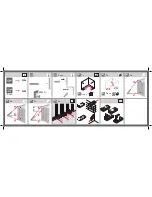
6-12
IM DL350-01EN
Tolerance Width (Width)
To create a real-time template for a channel, set the distance from the averaged waveform (of 1, 2, or 4 cycles
before the current waveform) that will be tolerated. The range within which you can set the distance varies
depending on the type of signal being measured.
Signal Type
Selectable Range
Resolution
Voltage
0.01 × the voltage scale to 10 × the voltage scale
Same as the trigger level
resolution
Strain
1 μSTR to (measurement range) × 2 or 0.0005 mV/V to
(measurement range) × 2
Acceleration
0.01 Unit to (Unit/div) × 10
For example, when Width is set to 2 V, the tolerance width is ±2 V around the averaged waveform.
Cycle Frequency (Cycle Frequency)
Set the trigger source frequency. If the actually frequency is within ±10% of the specified value, it is automatically
tracked.
Selectable range: 40 to 1000 Hz.
Resolution: 1 Hz
Reference Cycles (Reference Cycle)
Select how many waveforms before the current waveform are used to create the real-time templates. When the
sample rate is 500 kS/s and the number of channels used to make real-time templates is 9 or more, you can set
only the number of cycles to 2. Even if you select 4 cycles, only two are used.
1
The previous waveform is used.
2
Two previous waveforms are used.
4
Four previous waveforms are used.
If a surge or other abnormal waveform occurs in the reference cycle, the abnormal waveform will be included
in the averaged waveform, so the instrument will trigger on the next normal waveform. This may make it
appear is if the trigger has been delayed by a few cycles.
T
Trigger occurrence
Surge
Pre-trigger section
When you use the wave window trigger, we recommend that you set a pre-trigger length that is longer than
the reference cycle so that you can observe waveform abnormalities that occur in the reference cycle.
Sync Channel (Sync. Ch)
Select the channel used to detect the points at which waveform comparison for the wave window trigger starts
and stops. Select the synchronization channel by selecting Auto or a channel from CH1 to CH4 that has a
module that the wave window trigger can be used with.
Auto
Of the modules that the wave window trigger can be used with, the module with the smallest number is
automatically selected.
Level for detecting the start and end points: The center of the amplitude of the sync-channel signal measured for
0.5 seconds after the start of waveform acquisition.
Detection hysteresis: Same as the simple trigger hysteresis
CH1 to CH4
Select a channel whose module can be used with the wave window trigger. If triggering does not function
properly when you select Auto, you can specify an appropriate channel.
For the selected channel, you need to set the level for detecting the start and end points and set the detection hysteresis.
6 Triggering
















































